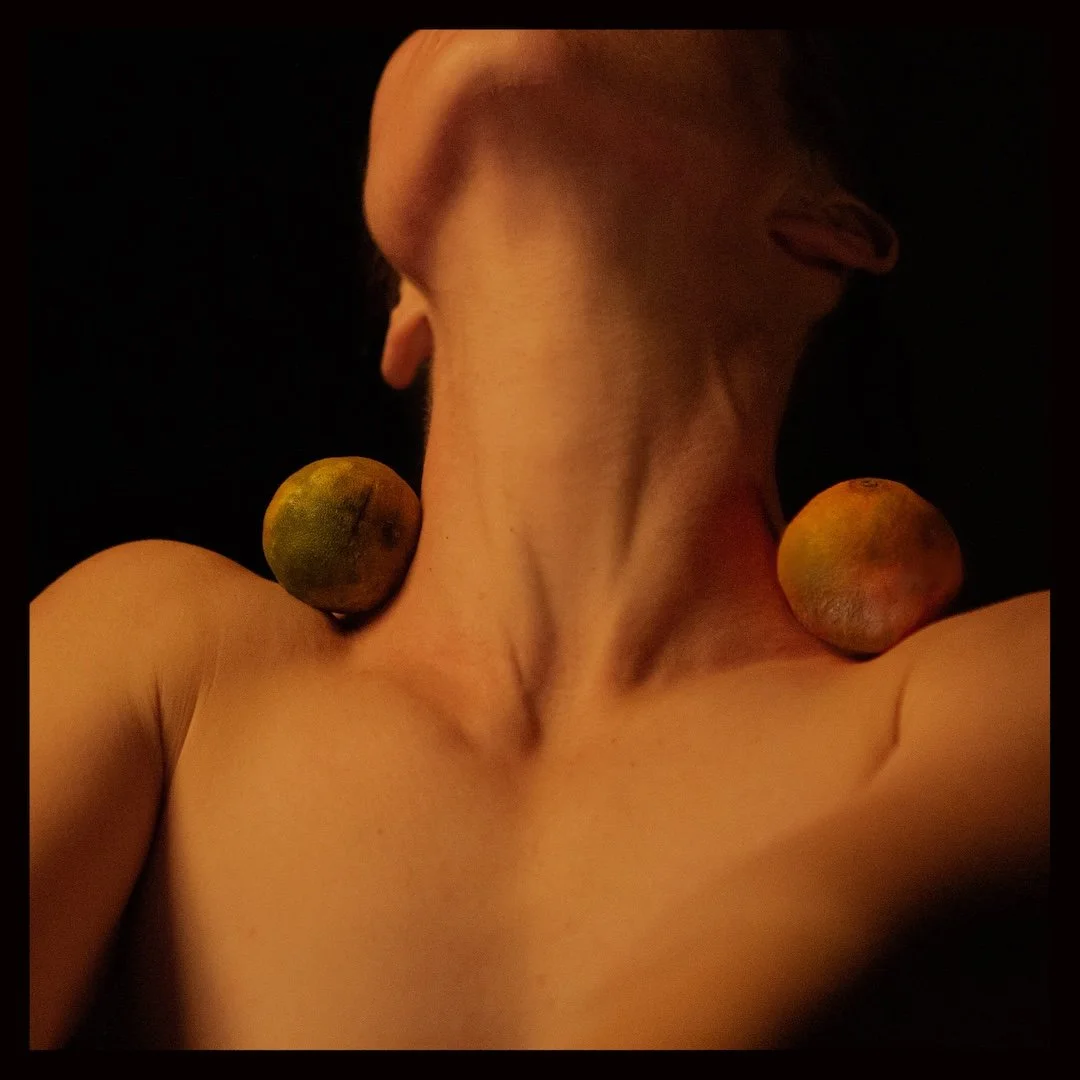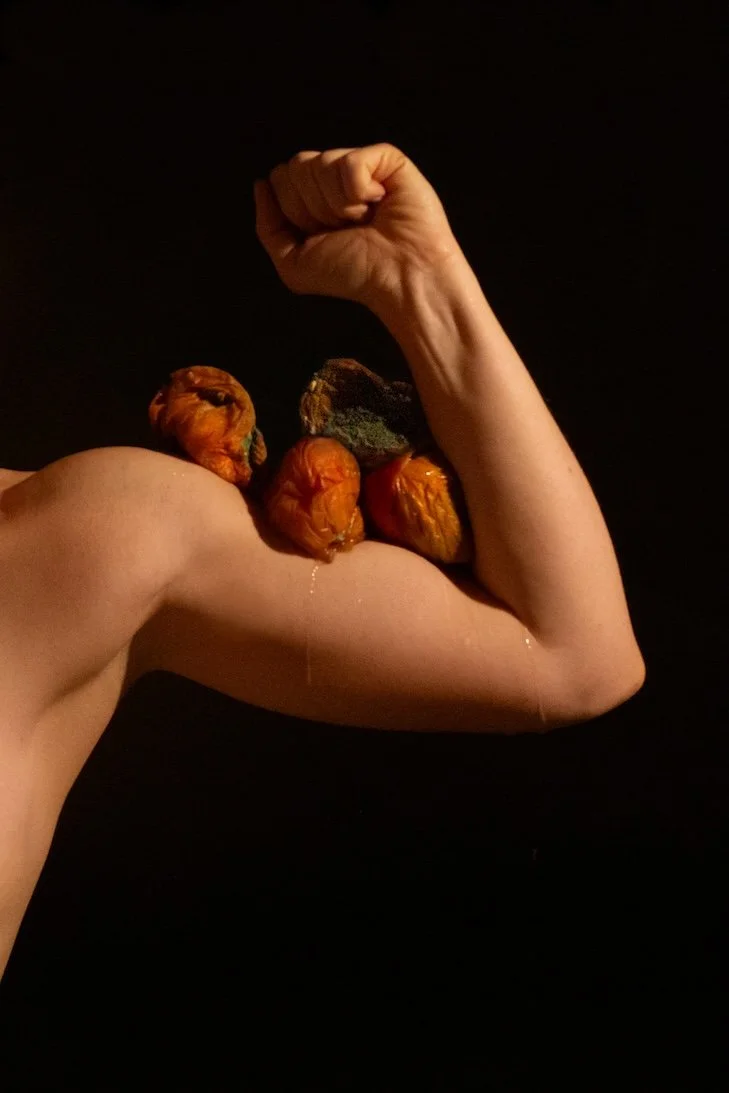NEITHER/NOR: TRACI REYNOLDS & LIZ JOHNSON
/NEITHER/NOR:
Traci Reynolds & Liz Johnson
July 3–September 5, 2025
Fenwick Gallery at Fenwick Library
Neither/Nor is a collaborative exhibition between Traci Reynolds and Liz Johnson, both MFA candidates in George Mason’s College of Visual and Performing Arts. Working with handmade paper and photography, the artists consider the gendered body as an in-between, non-conforming, unruly space. The gendered body—one that is perceived, shaped, disciplined, and transformed by normative standards and societal expectations—can at turns be seen as dangerous and vulnerable, alluring and repulsive, something to be feared and protected. Like pressing against a fresh bruise, both artists revel in the discomfort and subversive pleasure of this uncertain space.
In a series of photographic self-portraits, Ripe and Rot, Liz Johnson works with decaying fruit as a collaborator. Balanced and braced against her body, the fruit sometimes collapses under its own weight or is crushed by powerful limbs. Johnson uses these organic materials to navigate a complex terrain of fertility, time, and bodily transformation—not seeking an answer, but embracing entropy.
Traci Reynolds’s work, Raise, presents another view of the body (particularly the trans and non-gender-conforming body) as a site for deconstruction and reformation. This large-scale, abstracted, handmade paper sculpture is built through an intense process of beating fiber into pulp, molding and shaping each sheet, and imbuing the still-wet paper with hair and latex—symbolic forms of identity, protection, containment, and kink. Drawing from studies of the abject and the genre of body horror in film and manga, Reynolds’s paper forms are in continuous flux between beauty and the grotesque, tearing and repair, and containment and eruption.
Neither/Nor is on view in Fenwick Gallery through September 5, 2025. Visit masonexhibitions.org to learn more.
Artists’ Statements
Traci Reynolds, Raise
Paper pulp, hair, latex, resin, fiber, 2025-present
Raise is an ongoing installation and a deepening of my investigation into the Queer, Trans, and non-gendered body—a body that exists in flux and in resistance. This work emerges from my longstanding engagement with liminal spaces—the unstable thresholds between what is visible and hidden, self and other, the in-between zones where this body—my body—has always lived. Raise is a monument to that space.
Paper pulp, hair, and latex are my materials of resistance. Each holds memory and mutability—paper pulp, beaten and reconstituted into new forms; hair, a remnant of identity; latex, both protection and vulnerability, containment and kink. These materials speak to the non-gendered body—unstable, ungovernable, powerful in its ambiguity.
Visually, Raise draws from the body horror genre in film, anime, and manga, where transformation is grotesque, violent, and sublime. From the invasive biotechnological terrors of David Cronenberg’s Crimes of the Future and Coralie Fargeat’s The Substance, to the flesh-rending metamorphoses in Akira, Choujun X, and Dorohedoro, these cultural texts offer a mirror to the Trans experience—monstrous, a radical reconfiguration of form. In Raise, I seek to celebrate these gender-bending journeys—to lift the body from ash, to raise it.
With the violence of Trumpism resurgent and legislative attacks on our bodies intensifying, Raise becomes a call to hold space for what cannot be erased. This is not a clean body, not a safe body. It is a body that insists on agency, on being seen, touched, feared, and honored. Raise is both a hymn and a howl. It does not provide resolution. It offers the wound and the altar. It asks: what is sacred about ourselves? How do we live in the in-between? And, most importantly, what power lies in our stories, and in our resistance
Liz Louise Johnson, Ripe and Rot (of a Biological Clock)
Inkjet prints on paper, 2022-2025 (ongoing)
Ripe and Rot is a series of photographs and organic materials exploring the complex terrain of fertility, time, and bodily transformation. This work began as a conversation with my own body after years of hearing the warning: if you want to be a mother, your biological clock is ticking. But the clock metaphor never quite fit. What I’ve come to understand is that it’s not a clock at all, it's a biological bank. Literally the ovarian reserve. Most female mammals are born with a finite number of eggs, and each month, one is withdrawn. It doesn’t reset like a clock, it only depletes.
In this series, rotting fruit acts as both symbol and collaborator. I’m drawn to the way ripeness inevitably shifts into decay, how what was once sugary and sweet softens and breaks down and becomes muted, dull, and lumpy. These fruits do not fail; they simply follow their season, their order. Nothing is wasted. Nothing is wrong.
This process lives in the liminal space I’ve been in my work, the place between yearning for motherhood and the uncertainty of whether I’ll ever get the chance. This work does not aim to resolve the question of fertility and potential motherhood. Instead, it is just a conversation about the not-knowing and the place in-between holding onto the potential of fertility, and the slow acceptance of the depletion of its resources.









